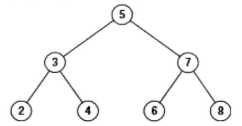面试题 63:二叉搜索树的第k个结点
题目:给定一颗二叉搜索树,请找出其中的第k大的结点。例如, 5 / 3 7 / / 2 4 6 8 (见下面的图1) 中,按结点数值大小顺序第三个结点的值为4。
图1:一个有7个结点的二叉搜索树,如果按结点数值大小顺序输出,则第3个结点的值是4
提交网址: http://www.nowcoder.com/practice/ef068f602dde4d28aab2b210e859150a?tpId=13&tqId=11215
分析:
对于二叉搜索树BST,在树中任取一棵子树,其节点值都满足:左结点的值 < 父节点的值 < 右结点的值,故如果按照中序遍历的顺序遍历一棵二叉搜索树BST,遍历序列的数值是递增序的。只需要用中序遍历算法遍历一棵二叉搜索树BST,就可以找出它的第k大结点。非递归中序遍历加上计数器即可解决。
6 / 3 8 / / 2 5 7 9
非递归实现 AC代码:
#include<cstdio>
#include<vector>
#include<stack>
using namespace std;
struct TreeNode{
int val;
struct TreeNode *left;
struct TreeNode *right;
TreeNode(int x) :
val(x), left(NULL), right(NULL) {
}
};
class Solution {
public:
TreeNode* KthNode(TreeNode* pRoot, unsigned int k)
{
TreeNode *p=pRoot;
TreeNode *resNode;
if(p==NULL || k==0) return NULL;
stack<TreeNode *> st;
unsigned int count=0;
while(!st.empty() || p != NULL)
{
if(p != NULL)
{
st.push(p);
p=p->left;
}
if(p == NULL)
{
p=st.top(); // 取当前节点
count++;
if(count==k) resNode=p;
st.pop();
p=p->right;
}
}
return resNode;
}
};
// 以下为测试
int main()
{
Solution sol;
TreeNode* root = new TreeNode(6);
root->left = new TreeNode(3);
root->left->left = new TreeNode(2);
root->left->right = new TreeNode(5);
root->right = new TreeNode(8);
root->right->left = new TreeNode(7);
root->right->right = new TreeNode(9);
TreeNode* p=sol.KthNode(root, 3);
printf("The value of Kth Node is: %d
", p->val);
return 0;
}而提交同样作用的代码到牛客网OJ却报错了: control may reach end of non-void function [-Werror,-Wreturn-type, 本地在Visual Studio和Dev C++上都测试通过的...
意思好像是没有在函数最外层写统一的返回值,改了就AC了...
class Solution {
public:
TreeNode* KthNode(TreeNode* pRoot, unsigned int k)
{
TreeNode *p=pRoot;
if(p==NULL || k==0) return NULL;
stack<TreeNode *> st;
unsigned int count=0;
while(!st.empty() || p != NULL)
{
if(p != NULL)
{
st.push(p);
p=p->left;
}
if(p == NULL)
{
p=st.top(); // 取当前节点
count++;
if(count==k) return p;
st.pop();
p=p->right;
}
}
}
};